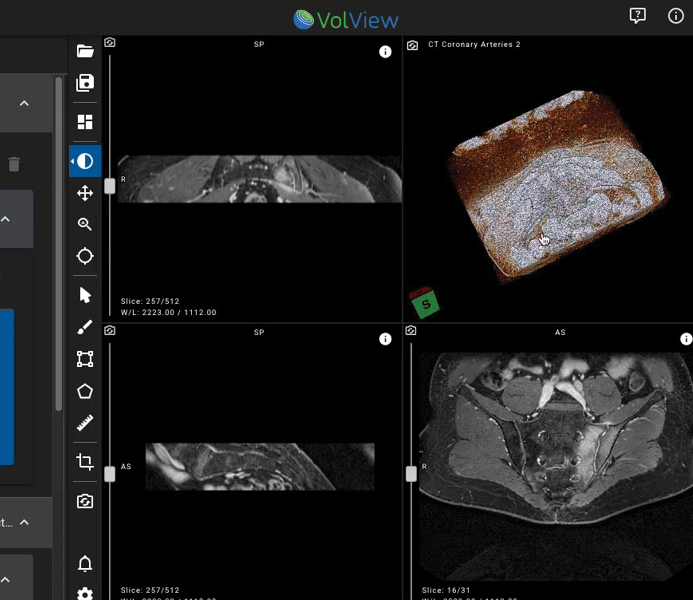Visualizing DICOM Images in VolView via Google Cloud Healthcare

Kitware recently introduced a new feature to VolView that enables seamless integration with Google Cloud Healthcare, allowing users to view DICOM images directly from the cloud. This enhancement provides a streamlined workflow for medical imaging professionals who need secure and efficient access to their datasets, and enables quick and easy visualization of datasets stored in Google Cloud Healthcare.
Uploading DICOM Data to Google Cloud Healthcare
To leverage this integration, users must first upload their DICOM data to Google Cloud Healthcare. The process involves:
- Setting up a Google Cloud project with the Healthcare API enabled.
- Creating a DICOM store and dataset.
- Uploading DICOM images using the Google Cloud command-line tool or API.
- Accessing the DICOM Web URL for integration with external viewers like VolView.
A sample Google Cloud Healthcare DICOMWeb URL structure looks like this:
/projects/sample-project-449822/locations/us-east1/datasets/my-sample-dataset/dicomStores/my-sample-datastore/dicomWeb/studies/1.2.276.0.50.192168001099.7810872.14547392.270Enabling OAuth Token Support in VolView
To make this integration possible, we added a crucial feature: OAuth token support in VolView. This ensures that users can securely pass authentication credentials along with image requests.
Key Enhancements:
- Passing OAuth Tokens: Users can now include access tokens when making requests to Google Healthcare DICOM Web endpoints. The easiest way to include an access token is via a URL parameter.
- Secure & Seamless Visualization: Once authenticated, VolView fetches and renders DICOM images without requiring additional user input.
Viewing DICOM Data in VolView
Once the data is uploaded and authentication is enabled, users can use VolView to load DICOM images directly from Google Cloud. To do so, users will need two things: an access token, and some information needed to construct the DICOMWeb URL.
Typically, an OAuth access token is obtained via an OAuth flow. For the purposes of demonstration, we can use the gcloud CLI tool to obtain an access token.
Install the gcloud CLI. Once installed, you should be able to run gcloud init. This will walk you through the OAuth flow. Be sure to log into the Google account associated with the Google Cloud Healthcare instance you wish to connect to!
After the OAuth flow is completed, running gcloud auth print-access-token will produce an access token that will be used in constructing the VolView URL.
After an access token is obtained, you can construct your DICOMWeb URL using information available from the Google Cloud Healthcare Console. The important information needed are:
PROJECT-ID: Your project IDLOCATION: The location of your data, e.g. us-east1DATASET-ID: The name/ID of your datasetDATASTORE-ID: The name/ID of your datastoreSTUDY-ID: A DICOM study ID that is available in your Healthcare datastore
A URL template is provided below. Once you fill out the angled-bracket placeholders, navigating to your constructed URL will load up VolView with your data!
https://volview-dev.kitware.app/
?token=
&dicomweb=https://healthcare.googleapis.com/v1
/projects/
/locations/
/datasets/
/dicomStores/
/dicomWeb/studies/As always, VolView never sends your data anywhere. Everything stays on your machine, so the data is as secure as your machine and Google Cloud Healthcare.
Demo Video
To see this feature in action, watch our demo video below:
Future Enhancements
While this is a significant step forward, we are considering additional features, such as:
- Enabling VolView as an OAuth 2 public client, in order to broadly support viewing of OAuth-protected resources.
- More integrations with cloud-based DICOM storage providers.
Want to explore more of what VolView can do? Check out the VolView website, and try the live demo or learn more about VolView in the documentation.
If you are interested in using VolView in your project, please reach out to us! You can leverage our expertise in web-based medical imaging workflows and visualizations to help build your next project.